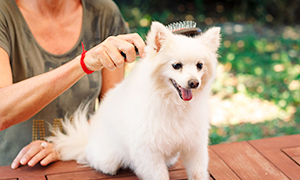Antimicrobial Peptides: The What, The How and The Why

This has largely driven the search for novel compounds to either replace or supplement conventional antibiotics and there are now a number of products available on the veterinary market that utilise anti-microbial peptides (AMP’s), either through the addition of synthetic AMP’s or through the inclusion of compounds known to stimulate production of naturally occurring ones.
AMP’s are small, cationic polypeptides which play a fundamental role in the innate immune system. They possess broad spectrum activity against bacteria, viruses and fungi, and modify the local inflammatory response through promotion of leucocyte chemotaxis. They are secreted from epithelial and immune cells, with upregulation occurring in the face of infection or injury. The two major sub-families in mammals are defensins and cathelicidins, which exhibit similar physical and functional properties.
In the face of invasion from a pathogen, AMP’s are involved in many different processes such as the recruitment of other immune cells and through more direct effects on bacteria/fungi. Defensins can directly attach to the cell wall of these pathogens and due to being positively charged, they are drawn into the negatively charged cell membrane and pair up to create a pore, ultimately causing cellular disruption and death.
The potential importance of skin defensins has been highlighted in studies of various skin disorders, for example the comparison of lesional skin from humans with atopic dermatitis (AD) to the skin of humans with psoriasis. The former group demonstrate a significantly lower defensin expression and are more prone to skin infection, despite both conditions being associated with a defective skin barrier2. It has therefore been hypothesised that a decreased production of AMP’s or production of non-functional AMP’s could be a possible cause of the higher susceptibility to skin infection in AD. However, in contrast to this, other studies have noted a significant increase in the expression of some AMP’s in both human and canine AD patients. A study by Santaro et al3 specifically studied AMP expression in actively infected skin of canine AD patients and found higher expression of some AMP’s and lower expression of others. They suggested it could be possible that an alteration of the ratio between AMP’s is the cause of increased infections in AD patients.
Harnessing this knowledge for therapeutic application is an area of increasing interest; certain plant extracts affect levels of AMP’s and a recent study in atopic dogs demonstrated a reduction in Staphylococcus spp. after 14 days of daily treatment with a water based spray containing 0.1% Peumus boldus leaf and Spiraea ulmaria, compared to a control group who just received a water based spray4.
From conducted studies, it’s clear that AMP’s are an important component of the innate immune system to defend against external micro-organisms and clearly warrant further investigation with regards to their role in modulating skin disease and how they can be utilised further as therapeutic agents.
1. Santoro D, Maddox C.W. Canine antimicrobial peptides are effective against resistant bacteria and yeasts. Vet Dermatol 2014; 25: 35–e12
2. Howell MD. The role of human beta defensins and cathelicidins in atopic dermatitis. Current Opinion in Allergy and Clinical Immunology 2007; 7: 413–7.
3. Santoro D et al. Evaluation of canine antimicrobial peptides in infected and noninfected chronic atopic skin. Vet Dermatol 2013;24:39-e10
4. Santoro D et al. Evaluation on the effects of 0.1% Peumus boldus leaf and Spiraea ulmaria plant extract combination on bacterial colonization in canine atopic dermatitis: A preliminary randomized, placebo controlled, double-blinded study. Research in Veterinary Science 118 (2018) 164–170


